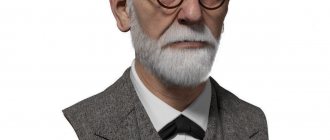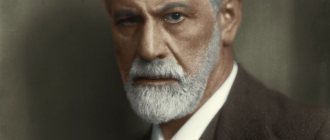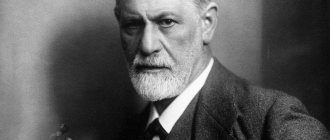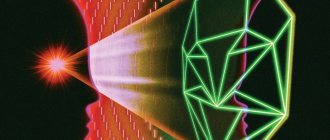Sigmund Freud (1856-1939) - Austrian psychologist, psychoanalyst, psychiatrist, founder of psychoanalysis and the psychoanalytic movement in general. In his research he made little use of the usual experimental approach, although he was convinced that his work was strictly scientific in nature. Freud also believed that analysis of patients' case histories and his own self-analysis provided sufficient basis for conclusions.
To a greater extent, S. Freud was interested in those subjects that, as a rule, had previously remained unattended: unconscious motivation of behavior, conflicts between the forces of the unconscious and their consequences for the human psyche.
Life instinct and death instinct
Instincts are the driving, motivational forces of the individual, biological factors that release reserves of mental energy. For Freud, instincts are not innate reflexes, but that part of the stimulation that comes from the body. The purpose of instincts is to eliminate or reduce stimulation through certain types of behavior (for example, eating or sexual activity).
Z. Freud identified 2 large groups of instincts: life and death.
Life instincts (Eros) include hunger, thirst, sexual activity and are aimed at the self-preservation of the individual and the survival of the species. These are creative, life-sustaining forces. The form of psychic energy in which they manifest themselves is called libido. Libido is a certain amount of mental energy that finds release exclusively in sexual behavior.
Freud believed that humans also have a desire for death. Death instincts (Thanatos) are destructive forces that can be directed both inward (masochism or suicide) and outward (hatred and aggression). Unlike the energy of libido, as the energy of the life instincts, the energy of the death instincts has not received a special name. However, Freud considered them biologically determined and as important in the regulation of human behavior as the life instincts. Towards the end of his life, Freud increasingly became convinced that the instinct of aggression could be very powerful as a motivating factor.
Levels of the structure of the psyche in the theory of S. Freud V. 20
S. Freud introduced the idea of the levels of structure of the psyche:
- unconscious - content that is fundamentally inaccessible to consciousness, including value systems, orientations, motives and leaving the energetic core of the personality. These are interests and needs that a person is not aware of, but which are inherent in him and manifest themselves in a variety of involuntary reactions and actions.
1. These may be erroneous actions: slips of the tongue, typos, errors when writing or listening to words. “They arise due to the opposition of two different intentions”: the collision of an unconscious motive and a consciously set goal of behavior.
2. Involuntary forgetting of names, promises, intentions, objects, events and other factors that are directly or indirectly related to unpleasant experiences. Such forgetting occurs against the will of the person and may be associated with negative feelings towards the person who bears the forgotten name, or towards events associated with this name.
3. Ideas associated with perception, memory and imagination: dreams, daydreams, daydreams. The content of dreams is associated with a person’s desires, feelings, intentions, unsatisfied or not fully satisfied important life needs of a person.
They do not correspond to hidden, unintentional intentions and are exceptions:
1. Children's dreams of preschoolers;
2. Infantile dreams of adults that arose immediately prior to sleep from emotional events of the past day;
- subconscious - emotionally loaded memories that can be realized using the technique of psychoanalysis (desires, thoughts, intentions, needs, repressed from the sphere of human consciousness under the influence of censorship);
- preconscious - content that, if necessary, can easily become conscious, for example, subliminal perception and a scheme for the implementation of automatic actions (walking, speaking, the ability to write, use various tools);
— consciousness is the reflexive content of consciousness, amenable to arbitrary regulation.
Consciousness controls the most complex forms of behavior:
1. When a person faces unexpected, intellectually complex problems that have no obvious solution;
2. When a person needs to overcome physical or psychological resistance;
3. When it is necessary to find a way out of any conflict situation;
4. When a person unexpectedly finds himself in a situation that contains a potential threat to him if immediate action is not taken, etc.
IN 20
Levels of the structure of the psyche in the theory of S. Freud
AT 21
Altered states of consciousness
Dream
Sleep is one of the functional states of a person. For a long time it was believed that sleep is simply a rest for the body, allowing it to restore strength expended during wakefulness. Lack of sleep has significant effects on behavior: some people hallucinate or become delusional after two to three days of sleep deprivation; others lose the ability to normally perceive tactile, visual, or auditory stimuli.
It is now known that sleep is not just a recovery period for the body, and the main thing is that it is not at all a homogeneous state.
Sleep goes through different stages: slow-wave sleep is followed by paradoxical sleep.
Slow wave sleep makes up about 80% of total sleep and has four stages in which brain activity occurs in progressively slower waves.
The paradoxical dream was discovered by Azerinsky and Kleitman in 1953.
This type of sleep is characterized by rapid eye movements (REM), brain activity, and a sharp drop in muscle tone.
Coma
Coma is a type of pathological deep sleep from which a person, although still alive, does not spontaneously wake up.
Coma occurs as a result of damage or destruction of the reticular formation due to illness, brain injury, or after taking certain drugs or poisons.
The brain continues to receive signals, but without the activating influence of the reticular formation, it is not able to decipher them. The patient is unconscious, insensitive to external stimuli and incapable of motor reactions.
AT 21
Meditation
Meditation is understood as a special state of consciousness, changed at the request of the subject. All types of meditation have one goal - to focus attention in order to limit the field of extroverted consciousness so much that the brain will respond rhythmically to the stimulus on which the subject is focused.
The transition to an altered state of consciousness can be accomplished in different ways. It can occur during a rhythmic dance, accompanied by the repetition of the same word, or in a complete retreat into the inner world (as with yogis). In both cases, the principle remains the same: you need to narrow the field of consciousness so much as to cut yourself off from the outside world.
Some people can achieve such a level of control during meditation that they can slow their heart rate or reduce their oxygen consumption by about 20%.
Meditation is satisfying because of the relaxation associated with it. This is a way that can help many people overcome stress.
Hypnosis
Hypnosis is a special psychophysiological state (different from sleep and wakefulness) that occurs under the influence of directed psychological influence - suggestion.
Hypnosis is not accompanied by physiological deviations from the waking state: brain waves most often remain the waves of a awake person, the content of oxygen and carbon dioxide in the blood is not changed, as happens during sleep or meditation.
In the hypothesis put forward by Fisher, the author views mental life as a series of layers corresponding to different levels of wakefulness. This allows them to live simultaneously on different levels when they are under the control of an external force.
AT 21
Psychotropic substances
Drug use causes pathological states of consciousness. No matter what substance we are talking about, they all affect the brain either by accelerating the transmission of sensory signals, or by blocking or modifying it, or by preventing some nerve centers from performing their function normally.
It is known that these effects are due to their influence on neurotransmitters - substances responsible for transmitting signals from one neuron to another at synapses.
With constant use, physical dependence is formed and if you stop using immediately, withdrawal syndrome may occur, sometimes with death.
With a sudden cessation of drug use in the case of psychological dependence, withdrawal syndrome of affective origin may occur.
Previous10Next
Three-component structural model of the psyche
In his early works, S. Freud singled out only the conscious and unconscious aspects of personality. The conscious part is small, as if it is only the tip of the iceberg, and in its essence is not significant. But the unconscious part is vast, occupying most of the iceberg. The subconscious mind contains the instincts and driving forces of human behavior.
Over time, Freud revised this simple division into conscious and unconscious and began to talk about the relationship between the three components of personality - Id (It), Ego (I) and Super-Ego (Super-I) .
1. Id (It) is a source of primitive biological drives and instincts, entirely related to the sphere of the unconscious. This is the most primitive and least accessible part of the personality; it is the original, primitive structure of the psyche. The id is closely related to biological drives (sleep, food, water, sexual desire, etc.) that energize human behavior.
Id stimuli demand immediate gratification without regard to anything else. They operate according to the pleasure principle, which seeks only opportunities to relieve tension by seeking pleasure and avoiding pain. The id is the main source of our psychic energy, libido, which manifests itself in the form of tension. An increase in libidinal energy leads to an increase in tension, which we then try in various ways to reduce to a normal level. For example, if a person is thirsty, he must satisfy his need for water. This will reduce the tension caused by thirst.
The id is like a small child who does not yet understand the rules of the world around him. He actively tries to get everything to satisfy his desires and needs, without assessing his capabilities and abilities, possible inconveniences for himself and others, as well as the consequences of his actions. For him, only “I want” exists, so the Id is controlled by the Ego.
2. Ego (I) is the rational and most conscious part of the personality, designed to adapt the impulses of the Id to social, economic and other restrictions imposed by the outside world.
This component of the psyche is responsible for decision making; this is the area in which intellectual processes occur. The ego seeks to express and satisfy the desires of the id in accordance with the requirements and restrictions imposed by the external world (in a way that is safe for the individual and adequate for society).
The ego is oriented toward causality and rationality, unlike the id. It follows the principle of reality, restraining the impulses of the id until a suitable object is found with the help of which the need can be satisfied and mental stress relieved.
The ego does not exist separately from the id. Moreover, the Ego derives its strength from the Id. The Ego itself exists, in fact, to help the Id.
3. Super-Ego (Super-I) is an internalized system of norms, rules and restrictions imposed on an individual by family and society, which is partly realized and partly remains in the unconscious.
The superego represents morality. From this it becomes clear why the Super-Ego cannot help but conflict with the Id, i.e. with a structure that does not recognize morality or any norms. Unlike the Ego, which tries to delay the fulfillment of the desires of the Id until a more appropriate opportunity, the Super-Ego intends to completely suppress these desires.
A person is not born with a Super-Ego. It is formed in the process of socialization - starting from the period when the child first learns what is “good” and what is “bad” and begins to distinguish between “right” and “wrong” (3-5 years). Children acquire a superego through their interactions with parents, teachers, and other “formative figures.”
As a result, the Ego appears, according to Freud, as an arena of continuous struggle between powerful and incompatible forces. He constantly has to maneuver between a rock and a hard place, trying to cope with the insistence and impatience of the id, correlate his actions with reality, relieve mental stress, and at the same time also deal with the continuous desire of the superego for perfection. In cases where the Ego is subjected to too much pressure, a situation called anxiety arises.
What is the basis of psychoanalysis
According to Freud, human mental nature is continuous and consistent . The appearance of any thoughts, desires and actions taken have their own reasons, which are characterized by unconscious or conscious motives. Thus, all actions performed have a direct reflection in the future of the individual.
Even in situations where emotional experiences seem unreasonable, there is a hidden connection between various events in human life.
Based on the above facts, Freud came to the conclusion that the human psyche consists of three different areas:
- consciousness;
- unconscious sphere;
- section of the preconscious.
The unconscious sphere includes basic instincts that are an integral part of human nature. This area also includes ideas and emotions that are repressed from consciousness. The reason for their repression may be the perception of such thoughts as prohibited, dirty and not worthy of existence. The unconscious area has no time frame. In order to explain this fact, it should be said that childhood experiences that enter the consciousness of an adult are perceived just as intensely as the first time.
The area of preconsciousness includes part of the unconscious area, which in certain life situations becomes accessible to consciousness. The area of consciousness contains everything that a person is aware of throughout his life. According to Freud's idea, the human psyche is driven by instincts and incentives that force an individual to perform various actions. Among all the instincts, 2 stimuli should be highlighted that have a dominant role:
- Life energy - libido.
- Aggressive energy is the death instinct.
The classical psychoanalysis of Sigmund Freud is aimed largely at the study of libido, the basis of which is sexual nature . Libido is a vital energy that is closely related to human behavior, experiences and emotions . In addition, the characteristics of this energy can be interpreted as the cause of the development of mental disorders.
Human personality contains three components:
- “Super-I” - Superego;
- “I” – Ego;
- “It” – Id.
“It” is inherent in every person from birth. This structure includes basic instincts and heredity. It cannot be described using logic, since “It” is characterized as disorganized and chaotic. It is important that it has unlimited influence on the ego and superego.
The topical model of the mental apparatus consists of 2 components: conscious and unconscious
“I” is one of the structures of the human personality that is in close contact with the people around us. “I” comes from “It” and appears at the moment when the child begins to perceive himself as an individual. “It” is a kind of feed for the “I,” and the “I” acts as a protective shell for basic instincts. In order to better understand the relationship between
"It" and "I", we should consider the example of sexual needs. “It” is a basic instinct, that is, the need for sexual contact. “I” determines under what conditions and when this contact will be realized. This means that “I” has the ability to restrain and control “It,” which is the key to internal psycho-emotional balance.
The “super-ego” originates in the “I” and is a kind of base where moral laws and rules are stored that limit the personality and prohibit certain actions. According to Freud, the task of the superego includes the construction of ideals, introspection and conscience.
All of the above structures have an important role in the development of human personality. They maintain a delicate balance between the danger associated with displeasure and the desire that leads to satisfaction.
The energy that originates in “It” is reflected in “It.” The task of the “Super-I” is to determine the boundaries of the action of this energy. It should be noted that the requirements of external reality may differ from the requirements of the “Super-I” and “It”. This contradiction is the cause of the development of internal conflicts. The following methods are used to resolve such conflicts:
- dreams;
- compensation;
- sublimation;
- defense mechanisms.
Based on the above, we can conclude that dreams are a recreation of human desires that cannot be realized in reality. Recurring dreams clearly indicate the presence of unrealized stimuli. Unfulfilled incentives interfere with self-expression and psychological growth.
Sublimation is a mechanism for redirecting sexual energy to those goals that are approved in society . Such goals include intellectual, social and creative activities. Sublimation is one of the protective mechanisms of the human psyche, and the energy created by it is the basis of civilization.
Anxiety caused by unsatisfied desires can be neutralized by directly addressing the internal conflict. Since internal energy is unable to find a way out, it is necessary to redirect it to overcome existing obstacles. In addition, it is necessary to reduce the consequences that these barriers can provide and compensate for unmet incentives. An example of such compensation is perfect hearing in people with visual impairments.
According to Freud, the human psyche is limitless.
Freud suggested that we are all driven by the pleasure principle.
A person who suffers from a lack of certain skills and wants to achieve success can achieve his goal through assertiveness and unsurpassed performance. But there are examples when the tension that arises can be distorted due to the operation of special protective mechanisms. Such mechanisms include:
- insulation;
- suppression;
- overcompensation;
- negation;
- projection;
- regression.
An example of how these defense mechanisms work should be considered in situations with unrequited love. The suppression of these feelings can be expressed by the phrase “I don’t remember this feeling,” the mechanism of rejection is expressed as “There is no love, and never was,” and isolation can be described as “I don’t need love.”
Personal defense mechanisms
Anxiety is a kind of warning that the Ego is in danger. Freud suggested that the Ego erects a kind of barrier against anxiety - defense mechanisms , which represent a subconscious denial or distortion of reality.
Defense mechanisms (psychological defenses of the individual) are certain types of behavior designed to protect the Ego (I) from anxiety generated by conflicts in everyday life.
1. Denial is the process of eliminating, ignoring the traumatic perception of external reality. For example, a terminally ill person denies the inevitability of death.
2. Substitution is the switching of id impulses from one object, inaccessible or fraught with a threat, to another, more accessible one. Those feelings and actions that should have been directed at the object that caused the anxiety are transferred to another object.
For example, replacing hostility towards your boss with pickiness towards your own child. In television reports about football matches, we often see how an attacker, who misses the target, sends the rebounding ball with a strong blow, in any direction. In this way, the accumulated energy is discharged.
3. Projection is a situation in which an anxiety-producing impulse is attributed to someone else. Most often, this is an unconscious mechanism through which impulses and feelings that are unacceptable to the individual are attributed to an external object and penetrate into consciousness as an altered perception of the external world.
He transfers (projects) his own desires, feelings and personality traits, which a person does not want to admit to himself because of their ugliness, onto another person.
For example, someone claims that in fact it is not he who hates his professor, but that he dislikes him. Or a stingy person, who, as a rule, sees in other people primarily greed, and an aggressive personality considers everyone around him to be cruel.
4. Rationalization is the reformulation of behavior in such a way that it becomes more understandable, more acceptable, and therefore less frightening to others. The function of rationalization is to disguise, hide from the consciousness of the subject the true motives of his actions, thoughts and feelings in the name of ensuring internal comfort, preserving self-esteem, self-respect.
Often this mechanism is used by a person to prevent the experience of guilt or shame. When this mechanism operates, the awareness of those motives that appear to be socially unacceptable or disapproved is blocked. A person, after some actions, actions dictated by unconscious motives, tries to understand them and rationally explain them, attributing to them more acceptable, more noble motives.
For example, you could claim that the job you just got fired from wasn't really that good.
5. Reactive formation is the replacement of one Id impulse with another, opposite to the first. A person hides impulses that disturb him by turning them into something opposite (alternatively, he can replace hatred with love). For example, someone who is constantly overcome by the desire to drink alcohol may suddenly become a passionate fighter for the passage of Prohibition.
6. Regression is a psychological defense mechanism consisting in the fact that a person, in his behavior when responding to very important situations, returns to early, childhood types of behavior that were successful at that stage.
The appearance in an adult of traits of childish, dependent behavior associated with happy times.
7. Suppression (repression) is the denial of the existence of some factor or event that causes anxiety. As a result of the action of this defense, thoughts, memories or experiences unacceptable to a person are, as it were, “expelled” from consciousness and transferred to the sphere of the unconscious, but at the same time they continue to influence the behavior of the individual, manifesting themselves in the form of anxiety, fear, etc. For example, involuntary repression from consciousness of certain memories or experiences that cause severe discomfort.
8. Sublimation is a change or replacement of some impulses of the Id through the switching of the energy of instinct to socially acceptable goals. There is a substitution of those needs that cannot be satisfied directly with socially acceptable goals.
For example, the transfer of sexual energy into the sphere of artistic creativity.
9. Identification is a defense mechanism in which a person sees another in himself and transfers to himself the motives and qualities inherent in another person. Identification also has a positive aspect, since with the help of this mechanism the individual assimilates social experience, masters new properties and qualities. For example, when using the identification mechanism, a person imitates the manners of some other person, whom he admires and who seems less vulnerable to him in alarming situations.
What is the structure of the psyche according to Freud?
Freud believed that in the same person there are several independent mental groups. Some groups are led by the conscious, while others are led by the unconscious. A mental element, for example, some idea, usually is not conscious for a long time. What is conscious at the moment, the next moment passes into the unconscious sphere, but with a slight effort of will it can be brought back again. What does it mean to make something conscious? This is to be able to translate a certain image, feeling or idea into a verbal shell. Freud gave the name “I” to consciousness and “It” to the unconscious. But there is also a “Super Ego”.
The human psyche, according to Freud, includes three areas - mental systems: conscious, unconscious and preconscious, which are in a state of continuous interaction with each other. The first two systems - conscious and unconscious - are characterized by a constant intense struggle that determines the functioning of a person’s entire mental life. The result of this struggle is every mental act and human act.
What is the main problem of the human soul and the two main ways to solve it, according to Freud?
The main problem of the human soul is to cope with anxiety.
2 ways to solve it:
1) solve the problem
2) do not admit the existence of a problem (denial)
18. How can you find out the content of the unconscious, according to Freud?
According to Freud, the process of “recognition” of the unconscious occurs when the content of consciousness is expressed in words. The patient freely expresses his thoughts without interference from the doctor. It seems that there is no connection between his thoughts, but there is a connection, it is hidden in the unconscious. The doctor must decipher these connections (associations) of the patient and reveal to the patient their hidden meaning. Freud called this the method of free association.
What is libido? How does Jung interpret libido, as opposed to Freud?
Libido (lat. libido) - desire, passion, attraction, which aims to achieve pleasure. In everyday understanding, libido is associated with sexual desire. Initially, S. Freud understood libido as only the energy of sexual desire, which has primarily an unconscious form. Then it was extended to other forms of behavior related to relationships with parents, children, and oneself. K.G. Jung views libido as a creative life force, as psychological energy in general, and sexuality as only one of the many possible manifestations of this energy.
Why did Freud attach great importance to childhood?
One of Freud's great discoveries was his awareness of the importance of early childhood. This discovery has several aspects. The baby already has sexual (libidinal) aspirations, although this is not yet genital sexuality, but, according to Freud’s definition, “pregenital sexuality”, which consists of the mouth, anus and skin. Freud recognized the falsity of the bourgeois idea of the “innocent” child and showed that from birth the small child is endowed with many libidinal aspirations of a pregenital nature.
What is the cause of neuroses, according to Freud?
Repressed from consciousness and blocked drives can break out both in the form of neuroses and in the form of somatic diseases.
What is sublimation?
Hysterical conversion is a change in the direction of affect in which it manifests itself in unusual bodily innervations and delays, which were the bodily symptoms of the case.
What is hysterical conversion?
Hysterical conversion refers to disorders in which physical symptoms arise on a psychological basis (without affecting the autonomic nervous system). The word "conversion" implies that the anxiety states experienced by the person have been converted into physical symptoms. As a result of conversion, a state of emotional indifference is achieved.
What does Freud call rationalization?
Rationalization is finding acceptable reasons for unacceptable thoughts and actions.
What was it about Freud's theory that both Jung and Adler objected to?
Jung and Adler expressed their disagreement with the teacher's overemphasis on sexuality and aggression as the focus of human life. Like Adler, Jung rejected Freud's claim that the brain is an “adjunct to the gonads.”
What new subsystem in the human psyche did Jung identify and on what basis?
Based on the analysis of dreams, delusions, schizophrenic disorders, as well as on studies of mythology, works of oriental, ancient and medieval philosophers, C. Jung comes to the creation of his analytical psychoanalysis.
Jung identified three structures in personality: the ego, the personal unconscious and the collective unconscious. The ego represents everything that a person is aware of. The personal unconscious contains suppressed and repressed experiences from the area of consciousness, as well as clusters of complexes, which are bundles of thoughts and feelings. The collective unconscious is the repository of the memory of humanity, it is the universal human emotional experience of all races and peoples, even traces of the experience of our anthropoid ancestors are hidden in it. The collective unconscious is not acquired in the individual life experience of the subject - it consists of archaic, primordial elements - archetypes, which contain the experience inherited from ancestors, predisposing to react in a certain way to what happens to a person. For him, the unconscious was not a group of rejected instinctive tendencies, repressed memories and subconscious prohibitions. He considered it a creative, rational principle connecting man with all of humanity and nature.
What are archetypes, according to Jung?
Archetype is a prototype, initial image, idea. Archetypes are passed on not only through learning and tradition, but also through heredity. Jung paid special attention to the trail. archetypes: persona, shadow, anima, animus, self.
What is individuation according to Jung?
Individuation is the individual’s acquisition of integrity, thus the desire for greater freedom, through combining the contents of the unconscious, restoring broken connections between different levels of the psyche. The process involves the development of a dynamic connection between ego and self with the integration of various parts of the psyche: ego, persona, shadow, anima and animus and other archetypes of the unconscious. As people become more integrated, they begin to express these archetypes in more subtle and complex ways.
What is existentialism? Name the representatives.
Existentialism (existenstia-existence) is a philosophical trend of the 20th century, the essence of which is the view of the world through the prism of the existence of the human person.
The origins of existentialism are in the teachings of S. Kierkegaard, F. Nietzsche, F. Dostoevsky.
Representatives of existentialism are German philosophers - M. Heidegger, M. Buber, K. Jaspers.
French philosophers - J. P. Sartre, G. Marcel, M. Merleau-Ponty, A. Camus.
Religious existentialism is distinguished by N. Berdyaev, K. Jaspers, G. Marcel and atheistic M. Heidegger, J. P. Sartre, A. Camus
The main themes of existentialism are human existence, the fate of the individual, the loss and acquisition of meaning in life.
According to this concept, what determines a person is not the external objective world, but the internal subjective one. The world is what man himself is, his subjective experiences.
What does "essence precedes existence" mean?
The method of use or purpose of the tool, that is, the essence of the tool, is determined by its creator even before production. In this case, essence precedes existence. In the same way, if God exists and He created man based on His idea, then it can be said that in the case of man, essence also precedes existence.
Psychosexual stages of personality development
Freud was convinced that the origins of neurotic disorders should be sought in the childhood experiences of patients. Thus, he became the first theorist to point out the importance of childhood research for understanding the nature of the psyche. In his opinion, the basic personality traits of a person are formed almost completely by the fifth year of life.
Z. Freud identified 5 stages of psychosexual development : oral stage (0-1.5 years), anal stage (1.5-3 years), phallic stage (3-6 years), latent stage (6-12 years), genital stage (12-18 years). Each of these stages is characterized by its own erogenous zone, its own neoplasms and its own characteristics.










